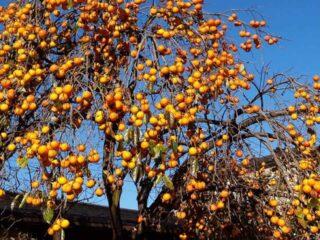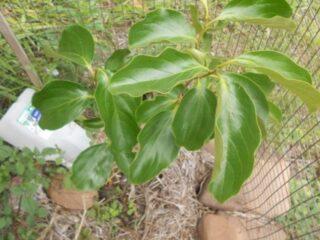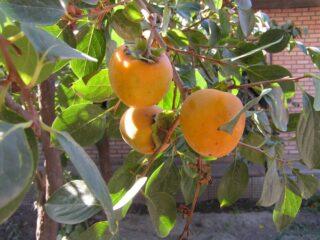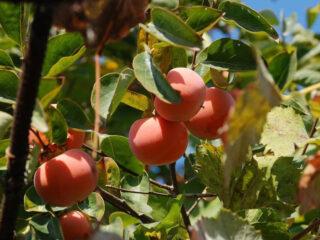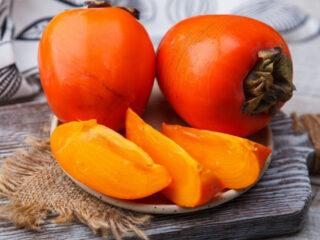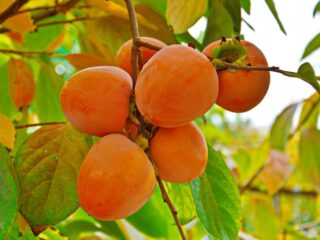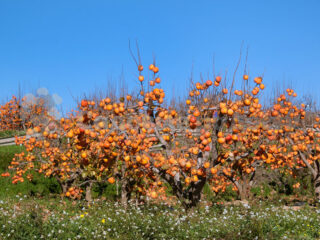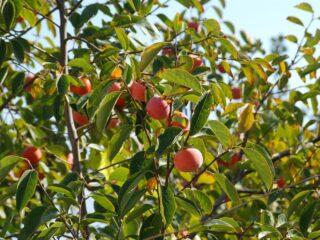Content
- 1 Description of persimmon variety Korolek with photo
- 2 Frost resistance of persimmon Korolek
- 3 Where Korolek persimmon grows in Russia
- 4 When the persimmon ripens Korolek
- 5 The composition and benefits of persimmon Korolek
- 6 Growing persimmon Korolek
- 7 Disease and pest control
- 8 Conclusion
- 9 Reviews of persimmon Korolek
Persimmon Korolek is one of the most common varieties growing in the subtropics of the Russian Federation. The plant was brought from China to Europe in the nineteenth century, but it was not appreciated for a long time due to the astringency of the fruit. Everything changed after they began to be eaten at the stage of their full maturity.
Description of persimmon variety Korolek with photo
Persimmon Korolek is often called chocolate or "black apple". Outwardly, the tree looks like a cherry, it can reach a height of twelve meters. Its leaves are oblong, dark green, lighter on the back. Persimmon Blossom Korolek begins in May. Single bright scarlet buds bloom on the branches. In the phase of full ripeness, the ovaries reach the size of an average apple, their shades from bright orange to brown. If the berries are unripe, they are tart, with an astringent taste and a slight bitterness. In October, the pulp acquires a creamy structure, a chocolate hue, and becomes sweet.
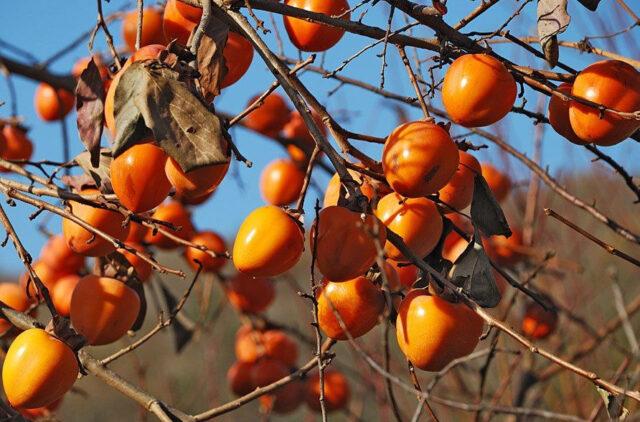
The shape of the fruit can be round, flattened, slightly elongated, cordate
Frost resistance of persimmon Korolek
Kinglet is an oriental persimmon. When grown in cold regions, the plantings must be covered, since the frost resistance of the plant is low - the trees can withstand temperatures down to -18 ⁰С.
A plentiful harvest greatly weakens the plants, reduces their winter hardiness. To increase it, special measures should be taken - to prune and feed trees on time, and carefully cover young seedlings in preparation for winter.
Where Korolek persimmon grows in Russia
The ancient Greeks called persimmon "food of the gods." It is grown in Japan, Australia, USA, China, Philippines and Israel. Although Korolek is unpretentious in care, a mild climate is required for full growth and ripening of fruits. In the Russian Federation, the variety is widespread in the Caucasus, in the Crimea, in the Stavropol and Krasnodar Territories, in the Volgograd Region.
When the persimmon ripens Korolek
Persimmon season begins after the first frost. In October, when the foliage from the trees completely falls off, the fruits ripen. Korolek reaches its ideal taste by November and December. The fruits cease to be viscous, acquire a sweet taste and juiciness.
The most delicious can be distinguished by translucent brown flesh, dark dots or stripes on the peel.
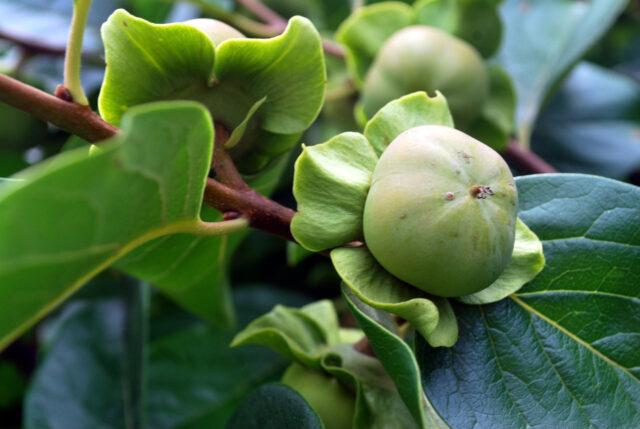
Rapidly growing ovaries form in place of the buds in July.
The composition and benefits of persimmon Korolek
Persimmon is considered a valuable and nutritious food for the human body. This is due to its rich chemical composition, which includes:
- Vitamin A - improves vision, strengthens the immune system.
- Vitamin C - helps to restore tissue, remove radicals.
- Vitamin E - has a positive effect on the reproductive system.
- Vitamin K - helps to strengthen bones and blood clotting.
- Vitamin B6 - has a positive effect on the functioning of the gastrointestinal tract.
- Thiamine - Essential for muscle and bone growth.
- Potassium - helps to supply oxygen to the brain, maintain memory and mental clarity.
- Copper - provides a normal metabolic process.
- Manganese - promotes the transmission of impulses between cells.
Regular consumption of persimmon has a beneficial effect on the cardiovascular, nervous, endocrine systems. In folk medicine, persimmon Korolek has found wide application. An infusion of the peel is used to treat allergies, the pulp is applied to burns, insect bites, a decoction of leaves can cleanse wounds from pus, fruit juice is used for scurvy.
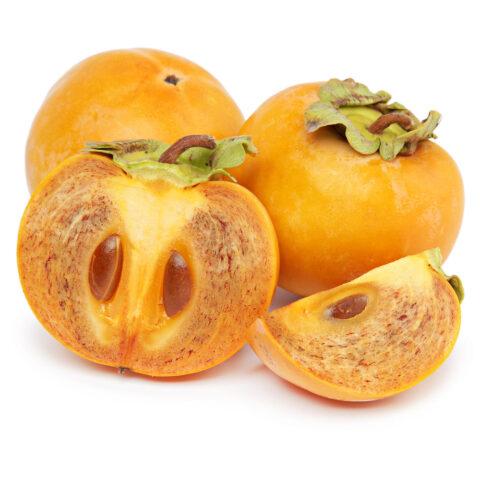
Persimmons are recommended to be eaten with edema, obesity, anemia and vitamin deficiency.
Growing persimmon Korolek
You can grow a persimmon tree on the site yourself or by purchasing a ready-made seedling. In the first case, the bone of the Korolek variety is removed from the fruit, washed and placed in the refrigerator for two months, wrapped in a damp cloth. Before planting, they are treated with a growth stimulator ("Epin") and buried 2 cm in a container filled with loose, moist soil (loam or sandy loam). Cover the top with a film or glass until shoots appear, removing only for watering or airing. After the emergence of the sprout, the shelter is removed and the small seedling is transferred to a place with diffused light.
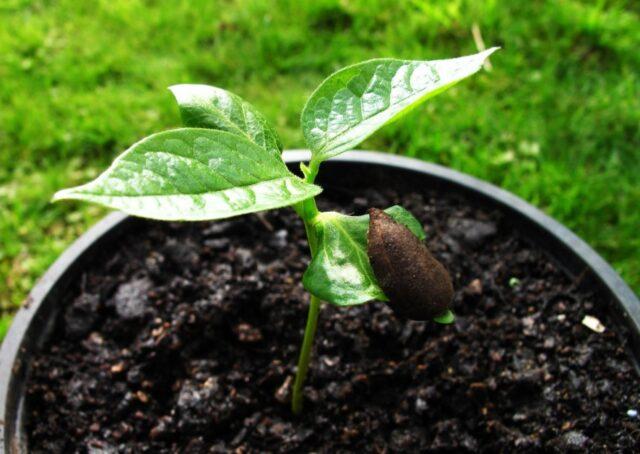
The seedling is grown for two years in a container, after which it is planted in open ground
Landing
The optimal time for planting persimmons is spring or autumn. In the second case, survival rate is better, but all work must be completed two months before the onset of frost. Choose a healthy seedling without signs of disease and damage, which is two years old.
It is believed that the lifespan of persimmons can reach five hundred years, so the choice of a place for a tree must be approached responsibly. Persimmon Korolek is a tall plant and enough space must be left for each, since the nutritional area of an adult tree is at least 64 square meters. The best area for him is near a wall or a high fence, well lit by the sun, protected from drafts and strong winds. Drained loam is suitable as a soil for persimmons. To correctly land, they act according to the algorithm:
- A pit with a volume of 50-60 liters is dug at the selected place two weeks before planting.
- At the bottom, a drainage layer is created from broken brick, pebbles, expanded clay.
- Pour humus on top in the form of a mound.
- The day before planting, the root system of the seedling is soaked in a solution of a growth stimulator.
- Install it in the center of the planting pit, straighten the roots.
- They are covered with soil and humus, without tamping the soil.
- A peg is placed next to it and a seedling is tied.
- Water abundantly (20 liters of water).
- Mulch the soil around the trunk.
It should be remembered that persimmon Korolek does not like swampy soils, since they contribute to root rot and plant death. If the site is located in low-lying areas, you need to create an elevation before proceeding with planting. Highly fertilized soils are not good for fruit trees. This circumstance can cause excessively rapid growth and inharmonious development of the crown. The further condition of the seedlings depends on the quality of their care.
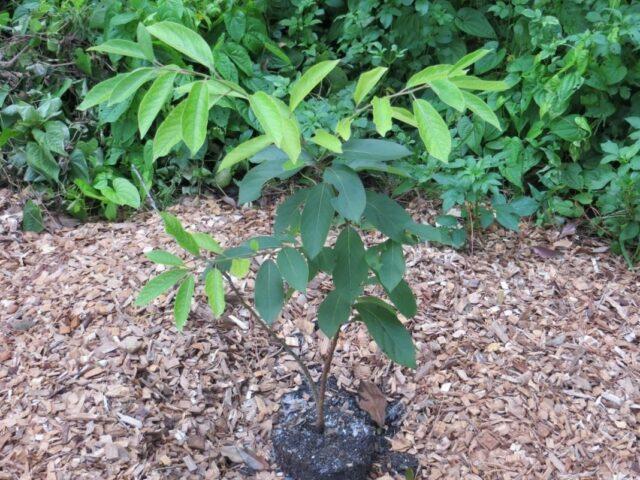
The first fruits can appear on young trees two years after planting.
Care rules
Persimmon Korolek is an unpretentious plant and does not require labor-intensive care, but responds to care very quickly. Attention should be paid to moistening the soil, feeding, pruning plants, protecting them from diseases and pests.
Watering, fertilizing
The kinglet loves frequent watering in the hot summer, but with waterlogging persimmons can greatly increase in growth, stretch out, and bear small, watery fruits. A day after watering, the trunks must be loosened and mulched with peat, compost or well-rotted manure.
The first feeding is carried out only eight years after planting the Korolek persimmon.Phosphorus-potassium fertilizers are introduced, which help the plants to prepare well for winter, survive frosts, lay flower buds, and give a rich and high-quality harvest. Korolek is fed three times per season - at the very beginning of spring, before flowering and in the phase of fruit formation. In addition to fertilizing the soil, foliar top dressing can be carried out using potassium iodide.

The tree grows poorly in drafts, in the shade and on the cold side of the site
Preparing for winter
To preserve young Korolek seedlings, it is necessary to ensure their protection from low temperatures. Use cardboard boxes, lutrasil and spruce branches. An additional layer of mulch with a thickness of 20 cm will help insulate the persimmon root system.
Pruning
The first shaping haircut is carried out immediately after planting. For this purpose, the central conductor is shortened to 80 cm, which stimulates the growth of skeletal branches. A year later, the trunk is shortened to 1.5 m, the lateral shoots are slightly trimmed, the damaged branches growing inside the crown and thickening it are removed.
Disease and pest control
If fruit trees are regularly looked after, they do not get sick. In the absence of proper care, the persimmon Korolek is attacked by ticks, caterpillars, foliage, buds and fruits, scab and gray rot are affected. To control pests and diseases, fungicides and insecticides are used, carrying out at least two treatments per season.
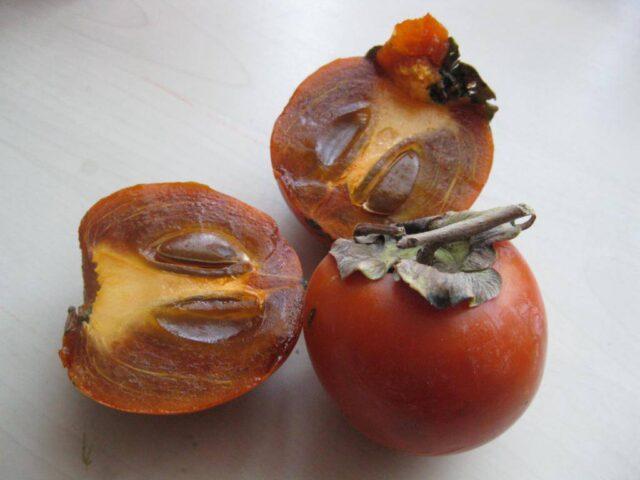
A distinctive feature of Korolek persimmon is the color of chocolate, sweetness and lack of astringent taste.
Conclusion
Persimmon Korolek is one of the most popular varieties among gardeners. This is due to the unpretentiousness of the trees, the excellent taste of the fruits and the possibility of growing in different climatic zones.
Reviews of persimmon Korolek
